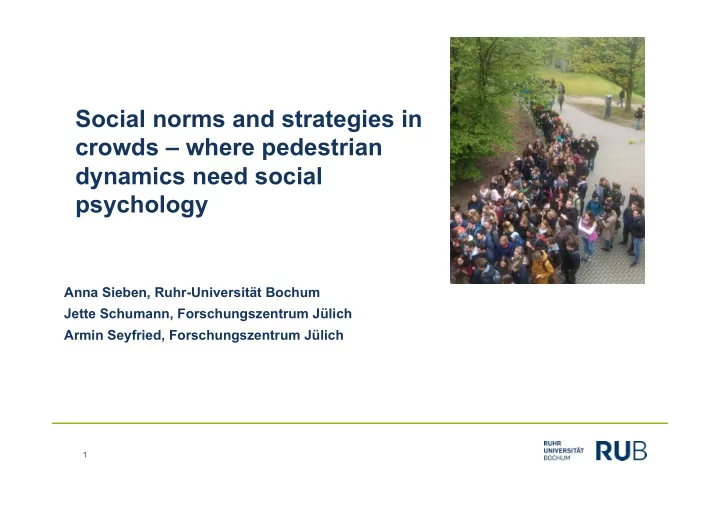

Social norms and strategies in crowds – where pedestrian dynamics need social psychology Anna Sieben, Ruhr-Universität Bochum Jette Schumann, Forschungszentrum Jülich Armin Seyfried, Forschungszentrum Jülich 1
1. Experimental setup • part of BaSiGo experimental studies • two structures of spatial barriers: semicircle setup and corridor setup • instruction: “Try to be one of the first to pass through the entrance” 2
Results: Density 3
Results: Density and its development over time 4
2. Questionnaire study • ex post study, participants did not take part in experiments • videos projected onto screen, participants asked to imagine to be standing in one of the designated areas • questionnaire contains of four parts: before and after watching video; setup semicircle and setup corridor (half of them in reverse order) • participants: 60 students (social sciences, engineering) 5
Variables in ques-onnaire: 6-point-scale: how just? • how likely to be one of the first 100? • how comfortable? • yes/no: can you contribute to accessing faster? • have you observed inappropriate behavior? • open-ended: strategies for accessing faster • forms of inappropriate behavior • social norms • 6
Results: Social norms open-ended quesGon: Which norms apply for this setup? in brackets: frequency of menGoning semicircle corridor the strongest wins/right of the norm of queuing/lining up (16) stronger (15) orderly behavior (11) no rules (15) pushing and shoving are first come, first served (7) forbidden (10)
Results: Level of comfort and perceived justness
Results: Observed inappropriate behavior yes/no quesGon: Have you observed inappropriate behavior? people showing inappropriate behavior semicircle corridor nobody/few 59,4 % 94,9 % a lot/all 40,6 % 5,1 % open-ended quesGon: Forms of inappropriate behavior semicircle corridor pushing and shoving (35) pushing and shoving (16) pushing someone aside (11) slightly pushing and shoving (4) jostling (9) jostling (3) standing sGll (3)
Results: Strategies for being faster yes/no quesGon: Can you contribute to accessing faster? contribu-on to faster access semicircle corridor before 78.3 % 71.7 % aOer 48.3 % 31.7 % open-ended quesGon: Strategies for accessing faster semicircle corridor pushing and shoving (25) pushing and shoving (21) using and filling gaps (10) staying on the leO hand side (11) using elbows/arms/shoulders (9) using and filling gaps (4)
Results: Summary semicircle corridor social norms right of the stronger queuing/no pushing level of comfort lower higher perceived justness lower higher observed inappropriate behavior more less contribuGon for faster access more less
3. Theoretical framework: Locating social psychology in pedestrian dynamics 12
3. Theoretical framework: Locating social psychology in pedestrian dynamics collec-ve ac-on pedestrians as human subjects psychological acGon-theoreGcal models e.g. norms, strategies 13
3. Theoretical framework: Locating social psychology in pedestrian dynamics collec-ve ac-on pedestrians as human subjects psychological acGon-theoreGcal models e.g. norms, strategies collec-ve behavior pedestrians as animals innate or learned sGmulus-response-associaGons, unconscious cogniGve processing e.g. swarms, flocks 14
3. Theoretical framework: Locating social psychology in pedestrian dynamics collec-ve ac-on pedestrians as human subjects psychological acGon-theoreGcal models e.g. norms, strategies collec-ve behavior pedestrians as animals innate or learned sGmulus-response-associaGons, unconscious cogniGve processing e.g. swarms, flocks collec-ve phenomena parGcipants as parGcles physical models e.g. lane formaGon, clogging at boUlenecks 15
4. Diagram for a static perspective keeping distance − density ± + pushing 16
4. Diagram for a static perspective moGvaGon for accessing + keeping distance prospect of + − success of pushing density ± perceived – + justness pushing – social norms against pushing 17
4. Diagram for a static perspective moGvaGon limited resources for accessing + strength of need/ keeping distance prospect of desire + − success of pushing spaGal structure density ± perceived – + justness transparent pushing procedure – social norms against pushing … 18
4. Diagram for a static perspective moGvaGon limited resources for accessing + strength of need/ keeping distance prospect of desire + − success of pushing spaGal structure density ± perceived – + justness transparent pushing procedure – social norms against pushing … external factors psychological variables behavior objecGve measure 19
Force-based models: F = F drv + F rep F drv = (V 0 – V)/τ V 0 = intended speed moGvaGon limited resources for accessing + strength of need/ prospect of desire + success of pushing spaGal structure density intended speed ± perceived – justness transparent procedure – social norms … against pushing external factors psychological variables behavior objecGve measure 20
Recommend
More recommend